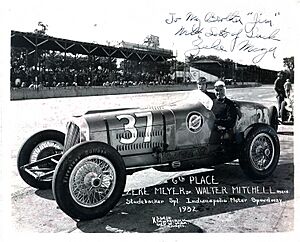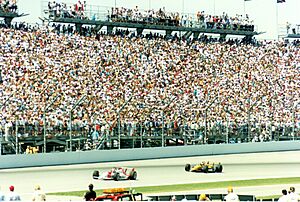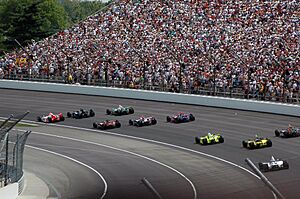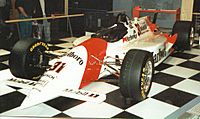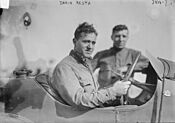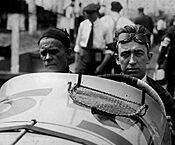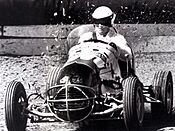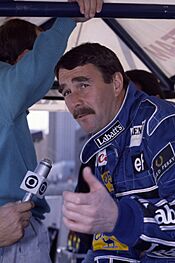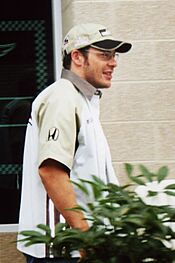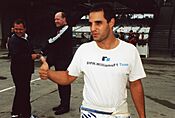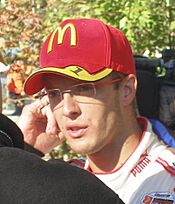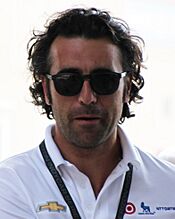American open-wheel car racing facts for kids
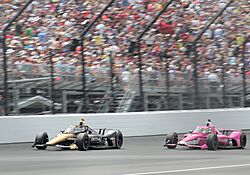
The 2023 Indianapolis 500, an IndyCar sanctioned race
|
|
| Highest governing body | AAA Contest Board (1905–1955) USAC (1956–1997) CART (1979–2003) Champ Car (2004–2008) IndyCar (1996–present) |
|---|---|
| Characteristics | |
| Contact | Yes |
| Team members | Yes |
| Mixed-sex | Yes |
| Type | Outdoor |
| Venue | Various |
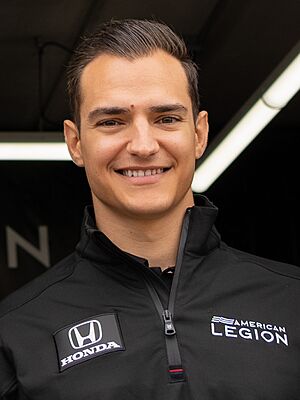
American open-wheel car racing, often called Indy car racing, is a type of professional automobile racing in the United States. Today, the top-level championship is run by IndyCar. This exciting sport has a long history, with races for special open-wheel race cars going all the way back to 1902.
A championship for drivers, where points are earned all season, has been officially recognized since 1905. For many years, this type of racing was known as Championship car racing or Champ car racing. But now, most people call it Indy car racing. This name comes from the famous Indy 500 race.
The cars, known as "Indy cars," are single-seat, open-cockpit vehicles built just for racing. They race on many different types of tracks, including ovals, road courses, street circuits, and tracks that combine parts of ovals and road courses. The biggest and most important race each year is the Indianapolis 500, held in late May. While Indy cars are similar to those in Formula One, they have some key differences. Even though the IndyCar Series is based in the U.S., races have sometimes been held in other countries like Canada, Mexico, and Japan.
This sport became very popular after World War II. In the 1950s, cars with engines in the front were popular. Then, in the 1960s, cars changed a lot, becoming more like modern race cars with engines in the back. Speeds on the big oval tracks went over 200 miles per hour! More drivers from around the world also started joining. The sport was very successful in the 1980s and 1990s. However, there were times when different groups disagreed on how to run the races, which led to "splits" in the sport. Luckily, the sport came back together in 2008. In 2019, IndyCar was bought by Roger Penske and his company, Penske Entertainment.
Contents
Groups That Run the Races
Over the years, different organizations have been in charge of American open-wheel car racing.
AAA (1902–1955)
The American Automobile Association (AAA) first started organizing car races in 1902. They created their own rules in 1903 and held the first season championship in 1905. Barney Oldfield was the first champion. While races continued, an official championship wasn't recognized again until 1916.
Racing didn't stop completely during World War I, but the official championship was paused. The Indianapolis 500 itself was also paused in 1917 and 1918 because of the war. The championship officially restarted in 1920 and kept going even during the Great Depression. However, all auto racing was stopped during World War II from 1942 to 1945 due to wartime rules. Racing fully returned in 1946.
AAA stopped being involved in auto racing at the end of 1955. This was mainly due to safety concerns after some serious accidents. Before 1922 and again from 1930 to 1937, it was common for race cars to have two seats. The driver would have a "riding mechanic" with them.
USAC (1956–1978)
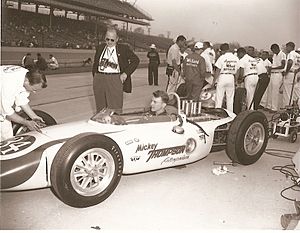
The United States Auto Club (USAC) took over running the national championship in 1956. USAC was started by Tony Hulman, who owned the Indianapolis Motor Speedway. Racing continued to grow. In the 1950s, front-engine "roadsters" were popular on paved oval tracks. But in the 1960s, cars quickly changed to rear-engine, formula-style racers. This brought new technology, higher speeds, and more costs. While most races were on ovals, a few road course races were added. Dirt track races were removed from the championship after 1970.
In the 1970s, the rising costs made it hard for some traditional USAC team owners to stay in the sport. New, strong teams like Penske and McLaren, with experience in road racing, became dominant. There were disagreements between these teams and USAC. Many races outside Indianapolis didn't have many fans or good promotion.
Towards the end of the 1970s, these disagreements led several team owners to think about starting a new group to run the races. Then, in 1977, Tony Hulman, the head of USAC, passed away. A few months later, several important USAC officials were killed in a plane crash. By the end of 1978, the team owners decided to break away and formed Championship Auto Racing Teams (CART) to take control of championship racing from USAC.
CART & USAC (1979–1981): The First "Split"
Championship Auto Racing Teams (CART) was started by most of the existing team owners. This meant there were now two national championships, one run by USAC and one by CART. The Indianapolis 500 stayed under USAC's control. Most of the top teams joined CART, and their championship quickly became the more important one. USAC ran a smaller season in 1979 with fewer famous drivers. At the 1979 Indianapolis 500, USAC tried to stop some CART teams from racing, but a court order allowed them to compete.
In 1980, USAC and CART tried to work together, but the Indianapolis Motor Speedway didn't like the idea. USAC then pulled out of the agreement. Both CART and USAC gave out separate championship titles that year. Johnny Rutherford actually won both!
For 1981 and 1982, the Indianapolis 500 was still run by USAC. The main national championship was now the one run by CART. Most of the Indy 500 racers were CART teams, plus some special "Indy-only" teams. Indianapolis was not part of the CART championship points system. USAC soon stopped running championship races outside of the Indianapolis 500.
CART & USAC (1982–1995)
Things became more stable. CART now ran the national championship full-time. The Indianapolis 500 was still run by USAC, but its points counted towards the CART championship. The cars and engines used in both CART races and the Indy 500 were mostly the same. The Indy 500 race included regular CART drivers and many "Indy-only" teams.
USAC had a rule that allowed "stock block" engines (engines based on regular car engines) to have more power from their turbochargers. While most CART teams used their special V-8 racing engines, some smaller teams chose to use stock block engines because of this rule.
USAC's own championship, called the Gold Crown Championship, continued. From 1985 to 1995, the USAC Gold Crown Championship only included the Indianapolis 500. This meant that whoever won the Indy 500 also won the USAC Gold Crown Championship by default.
CART & IRL (1996–2003): The Second "Split"
In 1994, Tony George, the grandson of Tony Hulman and president of the Indianapolis Motor Speedway, started the Indy Racing League (IRL). This new series began racing in 1996. It was a separate championship, and it used the fame of the Indianapolis 500 as its main event. The IRL announced that 25 teams competing in IRL races would automatically qualify for the Indy 500. This made it very difficult for most CART teams to get into the race, so CART teams boycotted the 1996 Indy 500. This was the start of the second "split" in open-wheel racing.
At first, USAC ran the IRL races. But after some problems with race officials in 1997, the IRL started handling its own officiating. CART had been using the "IndyCar" name, but the Indianapolis Motor Speedway owned the trademark. This led to a legal fight. They eventually settled, with CART giving up the "IndyCar" name. The IRL couldn't use it until 2003. CART then went back to just being called CART, and their cars were called "Champ Cars."
CART's championship was still very strong after the split. It kept most of the top drivers, teams, and sponsors for a while. However, in 2000, some CART teams started returning to the Indy 500, and eventually, many moved to the IRL permanently. By 2003, CART lost big sponsors and engine suppliers to the IRL.
IRL IndyCar Series & Champ Car World Series (2004–2007)
After losing teams, drivers, sponsors, and manufacturers, CART faced big financial problems and went bankrupt in 2003. A new group bought its assets in 2004 and renamed the series the Champ Car World Series. But this group also struggled financially. By 2007, major sponsors left.
During this time, the IRL was now called the IndyCar Series and was slowly becoming the main championship. In 2005, the IRL added road and street courses to its schedule, taking over some former CART race locations. Champ Car even raced in Europe again in 2007.
IndyCar (2008–2019): Coming Back Together
Before the 2008 season, Champ Car went bankrupt and was joined with the IRL. This created one unified series for the national championship for the first time since 1978! The combined series was called the IndyCar Series. The race calendars were merged, and popular Champ Car races like Long Beach and Edmonton continued. All the history and records of CART/Champ Car were taken over by the IRL.
In 2011, the Indy Racing League name was officially dropped, and the organization became simply IndyCar to show that the series was now merged. A new race car, the Dallara DW12, was introduced for the 2012 season. The series has had different sponsors over the years, being known as the IZOD IndyCar Series, Verizon IndyCar Series, and now the NTT IndyCar Series.
IndyCar (2020–Present): The Penske Era
In 2020, the IndyCar Series, along with the Indianapolis Motor Speedway and other related businesses, was sold to Penske Entertainment Corp. This company is owned by racing legend Roger Penske.
Car Names and Trademarks
The race cars in these championships have had different names. Early on, they were called "Championship Cars," which became "Champ Cars." Sometimes they were called "Big Cars" to show they were larger and faster than other race cars.
Since the USAC era, "Indy cars" (named after the Indy 500) became the most common name. When CART started in 1979, its name meant "Championship Auto Racing Teams," but they marketed themselves as the "CART Indy Car World Series."
In 1992, the Indianapolis Motor Speedway trademarked the name "IndyCar." They let CART use it until 1996. After the Indy Racing League started in 1996, there was a lawsuit. As part of the agreement, the "IndyCar" name couldn't be used for six years. CART then went back to calling its cars "Champ cars."
This situation was confusing. Even though CART/Champ Car races outside the U.S. were sometimes still called "Indy" events (like the Molson Indy Toronto), Champ Car slowly stopped using the name to distance itself from the IRL.
After the agreement ended in 2003, the "IndyCar" name came back. The Indy Racing League was renamed the "IRL IndyCar Series," and the cars were called "Indy cars." Even so, many people still used "IRL" to describe the series.
When the Champ Car World Series merged with the Indy Racing League in 2008, the name "Champ Car" was retired for good. The unified series became "IndyCar." On January 1, 2011, the names "Indy Racing League" and "IRL" were officially removed. The organization is now called INDYCAR LLC, and the main racing series is the IndyCar Series.
IndyCar vs. Formula One
At first, American and European open-wheel racing were quite similar. But in America, racing grew popular on oval tracks like the Indianapolis Motor Speedway. In Europe, racing on road courses became more popular. After World War II, Formula One was created as the World Championship for road racing, and F1 cars became very specialized and high-tech.
In the 1960s, road racing became more popular in North America, and Formula One-style ideas changed Indy cars. Indy cars, which used to be front-engine "roadsters," became rear-engine, formula-style cars. IndyCar became a championship that raced on both road courses and ovals. Compared to F1 cars, Indy cars were partly designed for oval racing: they were larger and had extra safety features for high speeds. Indy cars were also usually "customer" cars that teams bought from builders, making them less expensive than F1 cars, which each team designed themselves.
Over time, the power of F1 and Indy car engines has changed. But for now, F1 cars generally have much more power than Indy cars.
Drivers who have raced in both series often share their thoughts. Alex Zanardi, who raced in both F1 and CART, said that F1 cars were lighter and quicker out of turns, while CART cars were more stable and reached top speed faster. More recently, drivers like Callum Ilott and Christian Lundgaard have said that modern Indy cars feel like a mix between a Formula 2 car and a Formula One car on road and street courses. They noted that Indy cars are harder to drive than Formula 2 cars because they don't have power steering and have less downforce, but more horsepower. However, a Formula One car would still be much faster on a road or street course.
There's a debate about which series is tougher for drivers. Some point out that former F1 champions, like Emerson Fittipaldi and Nigel Mansell, have won CART championships. Other successful Indy car drivers have tried F1 but didn't always find success. However, a few notable Indy car drivers, like Mario Andretti and Jacques Villeneuve, went on to become Formula One champions. Romain Grosjean, a former F1 driver, said in 2021 that a modern Indy car is more physically demanding to drive than a modern Formula One car. But he also said that F1 cars are more mentally challenging because of their complexity, power, and the need to manage fuel during races.
Open-Wheel Cars
- "Indy car" is a general name for championship open-wheel auto racing in the U.S. It first described cars that raced in the Indianapolis 500-Mile Race. People started using "Indy car" to tell them apart from other open-wheel cars, like those in Formula One.
- Generally, Indy cars from both CART and IndyCar are slower on street and road courses. This is because they are less expensive and don't use as much cutting-edge technology as Formula One cars. For example, a top Indy car team might have a budget of around $20 million per season, while a Formula One team could have a budget of hundreds of millions.
- Since 1981, Formula One teams have had to build their own car chassis. But an Indy car chassis can be bought from a manufacturer. This has made the IndyCar Series mostly a "spec series," meaning all teams use very similar cars to keep costs down and make racing closer.
Racing Style
- Historically, Indy car racing mostly happened on high-speed oval tracks, while Formula One raced mainly on permanent road courses. However, the Champ Car series had no oval tracks in its last season (2007). The IRL, which started as an all-oval series, added road and street courses. Now, the IndyCar Series has a mix of ovals and road/street courses, though fewer ovals due to safety reasons.
- Indy car racing was mostly dominated by North American drivers until the 1980s and 1990s. Then, drivers from Europe, South America, and Japan, many of whom had raced in Formula One, started joining. This led to Tony George forming the IRL to promote American drivers. On the other hand, American drivers haven't had much success in Formula One since the 1970s.
- Because there aren't many American drivers and teams, Formula One has sometimes struggled to be popular in the U.S. But since 2023, there are three Formula One races held in the United States each year. In contrast, Indy car racing hasn't become very popular outside the U.S. and Canada, even though it has occasionally held races overseas.
Types of Race Tracks
The American National Championship is known for using many different kinds of racetracks, more than other series like Formula One. The main types of tracks used are:
- Paved ovals and tri-ovals (like Indianapolis and Texas)
- Permanent road courses (like Barber and Mid-Ohio)
- Temporary street circuits (like Long Beach and St. Pete)
- Combined road courses (tracks that use part of an oval and part of a road course, like the IndyCar Grand Prix)
Until 1970, the championship often raced on dirt and clay tracks, but these were removed from the schedule after that. From 1915 to 1931, races were often held on "board tracks" made of wood. However, these were dangerous and expensive to maintain, so most were taken down in the 1930s. The Pikes Peak Hillclimb was also part of the championship for several years.
Races Outside the United States
For most of its history, the national championship races have been held in the United States. However, American championship cars did race at the Monza oval in Italy in 1957 and 1958. There was also a non-championship race in Japan in 1966. The first championship races outside the U.S. happened in Canada in 1967. In 1971, a USAC race was held in Argentina. In 1978, two races were held in England.
Starting in the mid-1980s, CART expanded into Mexico and Canada. In the 1990s and early 2000s, races were held overseas in places like Australia, Brazil, and Japan. Towards the end of its run, Champ Car even raced in Europe at tracks like Assen and Zolder, trying not to compete with Formula One's schedule.
Trophies and Awards
Astor Cup
In 2011, IndyCar brought back the Astor Cup. This trophy was first given out in 1915 as the championship trophy. It now has a black granite base that shows the names of all the American Championship car racing winners since 1909.
Vanderbilt Cup
The Vanderbilt Cup races in 1916, 1936, and 1937 were part of the national championship. CART brought the Cup back in 1996 for the winner of the US500 race. When that race stopped, the Cup became the championship trophy. Champ Car kept the rights to use the trophy after CART's bankruptcy, but it was no longer used after Champ Car merged with the Indy Racing League.
The Indianapolis 500 and the Championship
Since it started in 1911, the Indianapolis 500 has always been seen as the most important event in Championship/Indy car racing. The race has been held every year except during World War I (1917–1918) and World War II (1942–1945). The Indianapolis 500 has been part of an official national championship since 1916 (except for the war years).
Winning the Indianapolis 500 is often considered almost as important as winning the whole national championship. Many national champions have also won the Indy 500 in the same year.
During the first "split" between USAC and CART (1979 to 1995), the Indy 500's role in the championship changed. The Indy 500 was run by USAC and was part of their Gold Crown Championship. Most of the teams and drivers, however, were from CART. The Indy 500 counted for CART points in 1979 and 1980, but not in 1981 and 1982. By 1983, an agreement was made so that the Indy 500, while still run by USAC, would count for points towards the CART championship.
Starting in 1996, the Indianapolis 500 became part of the new Indy Racing League championship. All connections to the CART championship were cut. This was the start of the second "split." In 2008, when the two series joined as IndyCar, the Indianapolis 500 became part of the unified IndyCar Series national championship. Since 2014, the Indy 500 has given double points towards the IndyCar Series championship, and extra points are given based on how well drivers qualify for the race.
Famous Drivers
- The driver with the most championship titles and race wins is A. J. Foyt. From 1959 to 1981, Foyt won 67 USAC championship races and seven USAC titles.
- Mario Andretti is the most successful driver born outside the U.S., with 52 total wins and 4 titles.
- New Zealand's Scott Dixon is the most successful non-U.S. driver with 6 championship titles and holds the record for IndyCar race wins (49). He is third all-time in total wins.
- Michael Andretti has won the most CART/Champ Car-sanctioned races (42).
- Tony Bettenhausen is credited with the most AAA championship race wins (19).
- Danica Patrick is the only woman to ever win a national championship-level open-wheel race (Motegi, 2008). Sarah Fisher was the first female driver to win a pole position (Kentucky, 2002).
- Four drivers have won both the CART Championship and the Formula One World Driving Championship:
- Six other drivers have won a national championship race and at least one Formula One Grand Prix:
National Champions
| Year | Champion | ||
|---|---|---|---|
| AAA National Championship | |||
| 1905 | |||
| 1906–1915: No championships | |||
| 1916 | |||
| 1917–1919: No championships (World War I) | |||
| 1920 | |||
| 1921 | |||
| 1922 | |||
| 1923 | |||
| 1924 | |||
| 1925 | |||
| 1926 | |||
| 1927 | |||
| 1928 | |||
| 1929 | |||
| 1930 | |||
| 1931 | |||
| 1932 | |||
| 1933 | |||
| 1934 | |||
| 1935 | |||
| 1936 | |||
| 1937 | |||
| 1938 | |||
| 1939 | |||
| 1940 | |||
| 1941 | |||
| 1942–1945: No championships (World War II) | |||
| 1946 | |||
| 1947 | |||
| 1948 | |||
| 1949 | |||
| 1950 | |||
| 1951 | |||
| 1952 | |||
| 1953 | |||
| 1954 | |||
| 1955 | |||
| USAC National Championship | |||
| 1956 | |||
| 1957 | |||
| 1958 | |||
| 1959 | |||
| 1960 | |||
| 1961 | |||
| 1962 | |||
| 1963 | |||
| 1964 | |||
| 1965 | |||
| 1966 | |||
| 1967 | |||
| 1968 | |||
| 1969 | |||
| 1970 | |||
| 1971 | |||
| 1972 | |||
| 1973 | |||
| 1974 | |||
| 1975 | |||
| 1976 | |||
| 1977 | |||
| 1978 | Year | CART Indy Car Series | |
| 1979 | 1979 | ||
| 1980 | 1980 | ||
| Year | USAC Gold Crown Championship | 1981 | |
| 1981–82 | 1982 | ||
| 1982–83 | 1983 | ||
| 1983–84 | 1984 | ||
| 1985 | 1985 | ||
| 1986 | 1986 | ||
| 1987 | 1987 | ||
| 1988 | 1988 | ||
| 1989 | 1989 | ||
| 1990 | 1990 | ||
| 1991 | 1991 | ||
| 1992 | 1992 | ||
| 1993 | 1993 | ||
| 1994 | 1994 | ||
| 1995 | 1995 | ||
| Year | Indy Racing League | 1996 | |
| 1996 | |||
| 1996–97 | 1997 | ||
| 1998 | 1998 | ||
| 1999 | 1999 | ||
| 2000 | 2000 | ||
| 2001 | 2001 | ||
| 2002 | 2002 | ||
| Year | IndyCar Series | 2003 | |
| 2003 | |||
| 2004 | Year | Champ Car World Series | |
| 2004 | |||
| 2005 | 2005 | ||
| 2006 | 2006 | ||
| 2007 | 2007 | ||
| Year | IndyCar Series | ||
| 2008 | |||
| 2009 | |||
| 2010 | |||
| 2011 | |||
| 2012 | |||
| 2013 | |||
| 2014 | |||
| 2015 | |||
| 2016 | |||
| 2017 | |||
| 2018 | |||
| 2019 | |||
| 2020 | |||
| 2021 | |||
| 2022 | |||
| 2023 | |||
- From 1979 to 1995, the Indianapolis 500 and the national championship were run by different groups, USAC and CART.
- From 1985 to 1995, the USAC Gold Crown Championship only included the Indianapolis 500. So, whoever won the Indy 500 also won that championship. However, IndyCar doesn't count these as full season championships.
IndyCar in Movies and Games
- The Crowd Roars (1932)
- Speed (1936)
- Indianapolis Speedway (1939)
- The Big Wheel (1949)
- To Please a Lady (1950)
- Roar of the Crowd (1953)
- Winning (1969)
- Super Speedway (1997)
- Driven (2001)
- Turbo (2013)
See Also
 In Spanish: Campeonatos de monoplazas de Estados Unidos para niños
In Spanish: Campeonatos de monoplazas de Estados Unidos para niños
- List of American Championship Car winners
- List of American Championship Car Rookie of the Year Winners
- List of American Championship car racing point scoring systems
- NASCAR Speedway Division
- American Indycar Series



